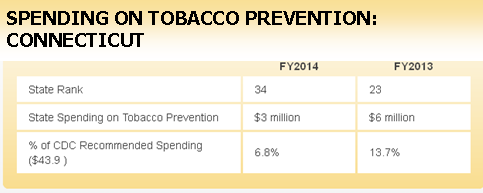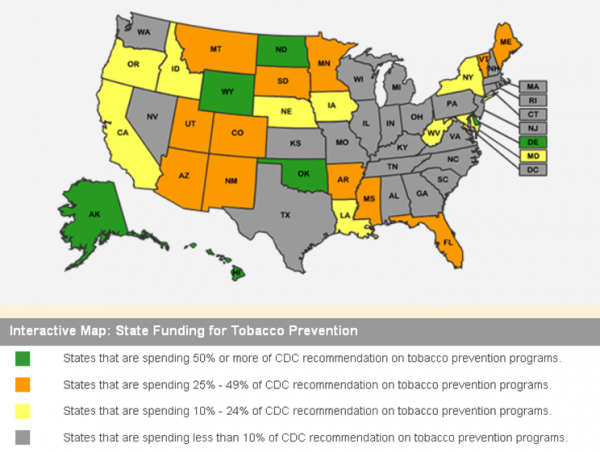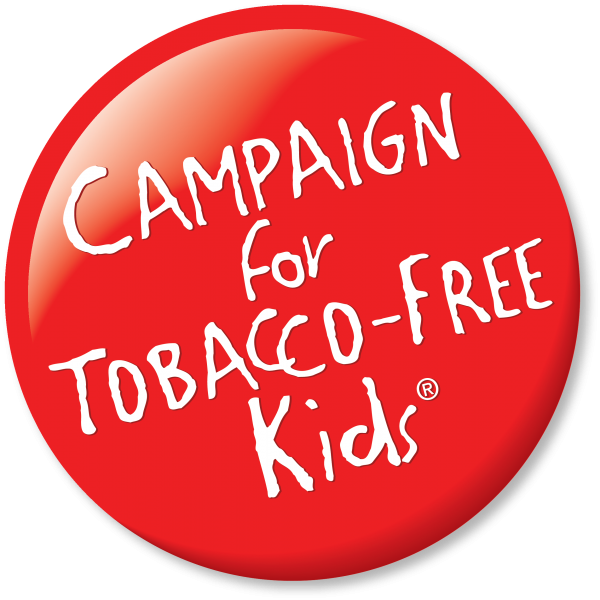CT Spending on Tobacco Prevention Goes Up in Smoke; E-Cigarettes Raise New Public Concerns
/
Fifteen years after the landmark state tobacco settlement in which Connecticut played a key role, the state now ranks 34th in the nation – down from 23rd a year ago - in funding programs to prevent youth from smoking and help smokers quit, according to a national report by a coalition of public health organizations.
In the current fiscal year, Connecticut is spending s $3 million on tobacco prevention and cessation programs, which is 6.8 percent of the $43.9 million recommended by the Centers for Disease Control and Prevention (CDC). Other key findings for Connecticut include:
- Connecticut this year will collect $466.1 million in revenue from the 1998 tobacco settlement and tobacco taxes, but will spend just 0.6 percent of it on tobacco prevention programs. This means Connecticut is spending less than a penny of every dollar in tobacco revenue to fight tobacco use.
- Connecticut has cut funding for tobacco prevention programs in half, from $6 million last year to the current $3 million; from 13.7 percent of the CDC recommended spending level down to 6.8 percent.
- The tobacco companies spend $78.1 million a year to market their products in Connecticut. This is 26 times what the state spends on tobacco prevention.
The annual report on states' funding of tobacco prevention programs, titled "A Broken Promise to Our Children: The 1998 State Tobacco Settlement 15 Years Later," was released by the Campaign for Tobacco-Free Kids, American Heart Association, American Cancer Society Cancer Action Network, American Lung Association, the Robert Wood Johnson Foundation and Americans for Nonsmokers' Rights.
The report comes as evidence increases that tobacco prevention an d cessation programs work to reduce smoking, save lives and save money. Florida, which has a well-funded, sustained tobacco prevention program, reduced its high school smoking rate to just 8.6 percent in 2013, far below the national rate. One study found that during the first 10 years of its tobacco prevention program, Washington state saved more than $5 in tobacco-related hospitalization costs for every $1 spent on the program.
d cessation programs work to reduce smoking, save lives and save money. Florida, which has a well-funded, sustained tobacco prevention program, reduced its high school smoking rate to just 8.6 percent in 2013, far below the national rate. One study found that during the first 10 years of its tobacco prevention program, Washington state saved more than $5 in tobacco-related hospitalization costs for every $1 spent on the program.
In Connecticut, 15.9 percent of high school students smoke, and 2,900 more kids become regular smokers each year, the organizations in the coalition pointed out. Tobacco annually claims 4,700 lives and costs the state $1.6 billion in health care bills, officials said.
"Connecticut once again is one of the most disappointing states when it comes to protecting kids from tobacco and needs to increase its investment in tobacco prevention," said Matthew L. Myers, President of the Campaign for Tobacco-Free Kids. "Tobacco prevention is a smart investment that saves lives and saves money by reducing tobacco-related health care costs. States are being truly penny-wise and pound-foolish when they shortchange tobacco prevention programs."
In 1997, when the settlement was announced, then-Attorney General Richard Blumenthal - a key negotiator in the tobacco settlement talks – described the accord as “a sweeping public health initiative to protect children from the lure of tobacco, save lives, and reimburse states for billions of taxpayer dollars spent on tobacco-related illnesses.”
 The national report assesses whether the states have kept their promise to use a significant portion of their settlement funds – estimated to total $246 billion over the first 25 years – to fight tobacco use. The states also collect billions more each year from tobacco taxes. Tobacco use is the number one cause of preventable death in the U.S., killing more than 400,000 people and costing $96 billion in health care bills each year. Nationally, about 18 percent of adults and 18.1 percent of high school students smoke.
The national report assesses whether the states have kept their promise to use a significant portion of their settlement funds – estimated to total $246 billion over the first 25 years – to fight tobacco use. The states also collect billions more each year from tobacco taxes. Tobacco use is the number one cause of preventable death in the U.S., killing more than 400,000 people and costing $96 billion in health care bills each year. Nationally, about 18 percent of adults and 18.1 percent of high school students smoke.
The report reveals that most states are failing to adequately fund tobacco prevention and cessation programs. Key national findings of the report include:
The states this year will collect $25 billion from the tobacco settlement and tobacco taxes, but will spend just 1.9 percent of it – $481.2 million – on tobacco prevention programs. This means the states are spending less than two cents of every dollar in tobacco revenue to fight tobacco use.
States are falling woefully short of the CDC's recommended funding levels f or tobacco prevention programs. Altogether, the states have budgeted just 13 percent of the $3.7 billion the CDC recommends. Only two states – Alaska and North Dakota – currently fund tobacco prevention programs at the CDC-recommended level.
or tobacco prevention programs. Altogether, the states have budgeted just 13 percent of the $3.7 billion the CDC recommends. Only two states – Alaska and North Dakota – currently fund tobacco prevention programs at the CDC-recommended level.
Public Expresses Concern Over E-Cigarettes
Within days of the report on tobacco prevention efforts, a national survey reflected public concerns about a new and increasingly popular alternative to traditional cigarettes, called e-cigarettes. Adults nationwide are concerned about the use of e-cigarettes by children and teens, with 44 percent indicating worries that the devices will encourage kids to use tobacco products, according to a new poll from the University of Michigan.
According to the latest University of Michigan Mott Children's Hospital National Poll on Children's Health, nearly half of parents are concerned their child will try e-cigarettes, which are battery-operated devices that look like cigarettes but don't burn tobacco. E-cigarettes have replaceable cartridges of liquid containing nicotine, which is inhaled as a vapor along with flavors like chocolate, fruit, candy or even tobacco.
"This poll shows high levels of concern about e-cigarettes and the possibility that kids who try them could start smoking tobacco," says Matthew M. Davis, M.D., M.A.P.P., director of the C.S. Mott Children's Hospital National Poll on Children's Health.
In the poll, which was administered in November 2013 to 2,124 adults age 18 and over, arguments were presented both for and against e-cigarettes. Then adults were asked for their opinions about the devices and possible regulations and laws.
Advocates of e-cigarettes say they are a healthier alternative to tobacco smoking and argue it may help smokers to quit. Critics counter that e-cigarettes may have health risks and may encourage people and kids or teens to smoke tobacco. Currently, e-cigarettes are not regulated by the U.S. Food and Drug Administration. Twenty-six states have regulations prohibiting sale to minors; Michigan's legislature currently has bills pending that prohibit those sales.
In the poll, 86% of adults said they have heard of e-cigarettes, while only 13% have ever tried one. Among parents, 48 percent said they are very or somewhat concerned that their children will try e-cigarettes. Meanwhile, 65% of adults think e-cigarettes should have health warnings like tobacco cigarettes and nicotine products.
Adults also expressed widespread support for new laws regarding e-cigarettes: 88% think manufacturers should be required to test e-cigarettes for safety and 86% favor prohibiting the sale of e-cigarettes to minors. 71% of adults support restricting the marketing of e-cigarettes on social networking sites.
"E-cigarettes are a relatively new product, with little information about safety or long-term health effects. However, the public is clearly aware of the devices and concerned about their impact, according to this month's poll results," says Davis, who is professor of pediatrics and internal medicine at the U-M Medical School and professor of public policy at U-M's Gerald R. Ford School of Public Policy. "In 2010, the poll also asked about e-cigarettes and at that time only one-third of adults had heard of the product. In this poll, that number jumped to 86 percent."
Earlier this year, CT by the Numbers reported that state Attorney General George Jepson and U.S. Senator Richard Blumenthal were among those calling for regulation of e-cigarettes.





























